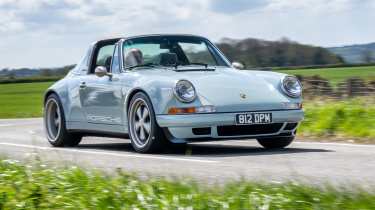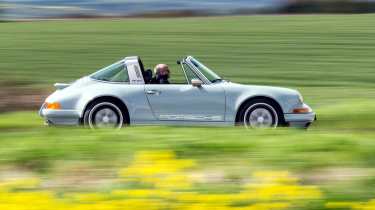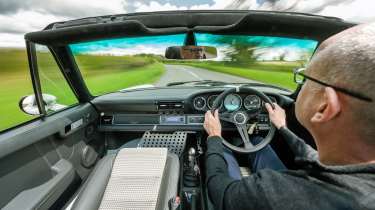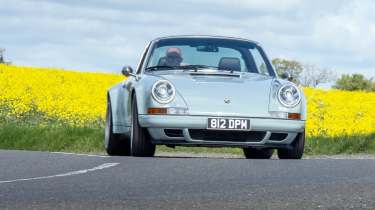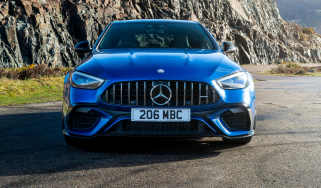Theon Design GBR003 2024 review – a Porsche 911 Targa with GT3 performance
For its third UK commission, the Oxfordshire-based Porsche restorer and enhancer has turned its attention to a Targa, and the result is out of this world
Its Larimar Blue paintwork glimmers in the rare UK sun, the silver roll hoop and bullet-head mirrors reflecting the few pure white clouds in the rich blue sky. Those 18-inch Fuchs replica wheels fill every centimetre of spare space under the carbonfibre arches, the lip spoiler fixed to the underside of the front bumper noticeable but not dominating your attention. Likewise the quarter-height ducktail sweeping up from the engine cover that’s subtle rather than overt, and the white Porsche script running through the ghosted body-colour stripes along the flanks of GBR003, Theon Design’s first Targa creation. Like all the best restomods the details are hidden in plain sight, every glance serving up a new delight.
Swing the steel driver’s door open (these are the only non-carbon exterior panels as they allow the 964 donor car’s side-impact protection to remain) and you stop to take another moment. Liquorice leather covers many of the surfaces, including much of the carbonfibre that replaces Porsche’s original trim to save yet more weight. Drilled aluminium footrests, aluminium gearlever sprouting from the floor, and the same material wrapping around the dials, with a colour-matched tacho in your centre line. A deep-dished leather-rimmed wheel waiting to be grasped. Every little detail is a distraction. You want to touch them all, feel their perfectly weighted movement and savour their precision.
More reviews
In-depth reviews
- Porsche 911 Carrera GTS T-Hybrid review – the first hybrid 911 is one of the best
- Used Porsche 911 (991, 2011 - 2018) review – should you buy the unloved 911?
Long term tests
Reviews
- New Porsche 911 Turbo S review – McLaren Artura performance with four seats
- RML GT Hypercar review – the Porsche 911 taken to the ultimate extreme
- Used Porsche 911 (997, 2004 - 2012) – the ultimate sweet spot 911
- Porsche 911 Turbo S (992.1, 2020 - 2024) review – Stuttgart’s supercar slayer
- Porsche 911 3.2 Carrera (1984 - 1989) review – flawed but furiously charming
> The Kalmar 7-97 E-Volt is an electric Porsche 911 with a plant-based body
And then it all goes out of the window when you’re handed the sliver of a key, insert it into the ignition barrel, call your left peg into action to depress the clutch, then twist your right wrist. Instantly you forget every little detail your brain has been processing for however long you’ve been staring and enjoying the silence.
There’s no explosion of revs, booming exhaust or gnarly, raspy tickover of a fragile racer, simply the most measured, balanced tone of a meaty engine capacity perfectly served by an expertly conducted intake and exhaust orchestra. It’s the soundtrack you expect every old 911 to make, but very few do as they hunt for revs. Not here. Not now. Thirty years of engine development has, as is often the case with modern builds of old engines, resulted in a motor its original creators could only have dreamt of. This is not to put Porsche’s past masters in the shade, but modern materials and decades of experience allow old engines to become modern masterpieces.
This motor started life as a 3.6-litre air-cooled six before being taken from 1993 (the year the base car was produced) and brought into 2024. Capacity has been increased to 4 litres, the compression ratio set to 11.3:1 and the ITB individual throttle bodies breathe through open induction trumpets that distract you from the leather-lined firewall. Cats and lambda sensors remain, but power and torque are no longer what they were: 403bhp arrives at 7100rpm and 320lb ft at 5500rpm in a car Theon claims weighs just 1228kg with a full complement of fluids (to save you looking for your calculator that’s 333bhp per ton – an exact match for a Gen 1 991 GT3).
You feel every measurement of its performance output. For the first two-dozen miles while the fluids are warming through you ride that torque curve, experiencing a hint of its muscular thump as you short shift around 3000rpm. The six-speed shift is nothing like that of a mid-’90s 993 Carrera, which is where it’s taken from. There’s a precision to it that the factory never truly mastered for its Carrera models as it did for its RS products, which is what Theon has based its transmission on. The gate feels tight, slack-free and instinctive. Each upshift brings with it a drop in revs, the lighter single-mass flywheel sees to this, but you always land back in a torque sweet-spot as you continue to watch the temperature gauge rise to where it needs to be.
At the first sign the warming-up process is complete, the GBR003 erupts into life as you squeeze the throttle harder, watch the revs build and the horizon grow in front of your eyes. It’s been far from docile up until this point, but this is a whole new level. Push beyond 4000rpm and the cacophony of noise builds over your shoulder. Your pace increases with equal excitement. More revs, another gear, more noise. Pure magic. Approach the 7000rpm peak and you’re thankful for the orchestral accompaniment of the soundtrack to mask your squeals of uncontrolled joy. Another gear. Rinse and repeat. It’s as visceral as driving a Caterham, as exhilarating as nailing a pre-991 GT3 and as intoxicating as a full-bloodied V12 supercar.
When it comes to slowing down, the process is repeated but in reverse. Your only frustration is that you want more gears so you never need to stop the heel-and-toe downshifts. The trade-off is that this means you’re about to tackle a corner. The 993 Carrera RS brakes have slowed you, the Michelin Pilot Sport 4 rubber has a purchase on the surface, and as you pour the Theon through the turn it feels connected and tied down, the process as one.
Left in their default setting the switchable adaptive dampers offer a blend of body control and ride comfort that perfectly suits British roads, but even when you experience the stiffer settings there’s a compliance and comfort level that keeps the car useable across multiple surfaces and conditions. A 48:52 weight distribution helps with the balance (the dual air-conditioning compressors and an all-new electro-hydraulic pump for the steering – linear in its action, detailed in feedback – are relocated to the front), while the lighter kerb weight contributes to the quick, clean directional changes. Some will crave more movement across the rear axle, a little more opportunity to slip around a corner than the wide, 275-section rear rubber allows, but this is more a GT with an edge than a track special with air-con.
This comes – as you have well suspected – at a price: £415,000 for a Targa commission, not including a donor car and local taxes. But like all restomods there’s so much more to the project than how much it costs, because the value is in the experience it delivers and, like the very best of their kind, GBR003 delivers a remarkable one.
Theon Design GBR003 specs
| Engine | Flat-six, 4.0 litres |
| Power | 403bhp @ 7100rpm |
| Torque | 320lb ft @ 5500rpm |
| Weight | 1228kg (333bhp/ton) |
| Tyres | Michelin Pilot Sport 4 |
| 0-62mph | <4.2sec (est) |
| Top speed | 160mph+ (est) |
| Price | £415,000 |
This story was first featured in evo issue 323.

